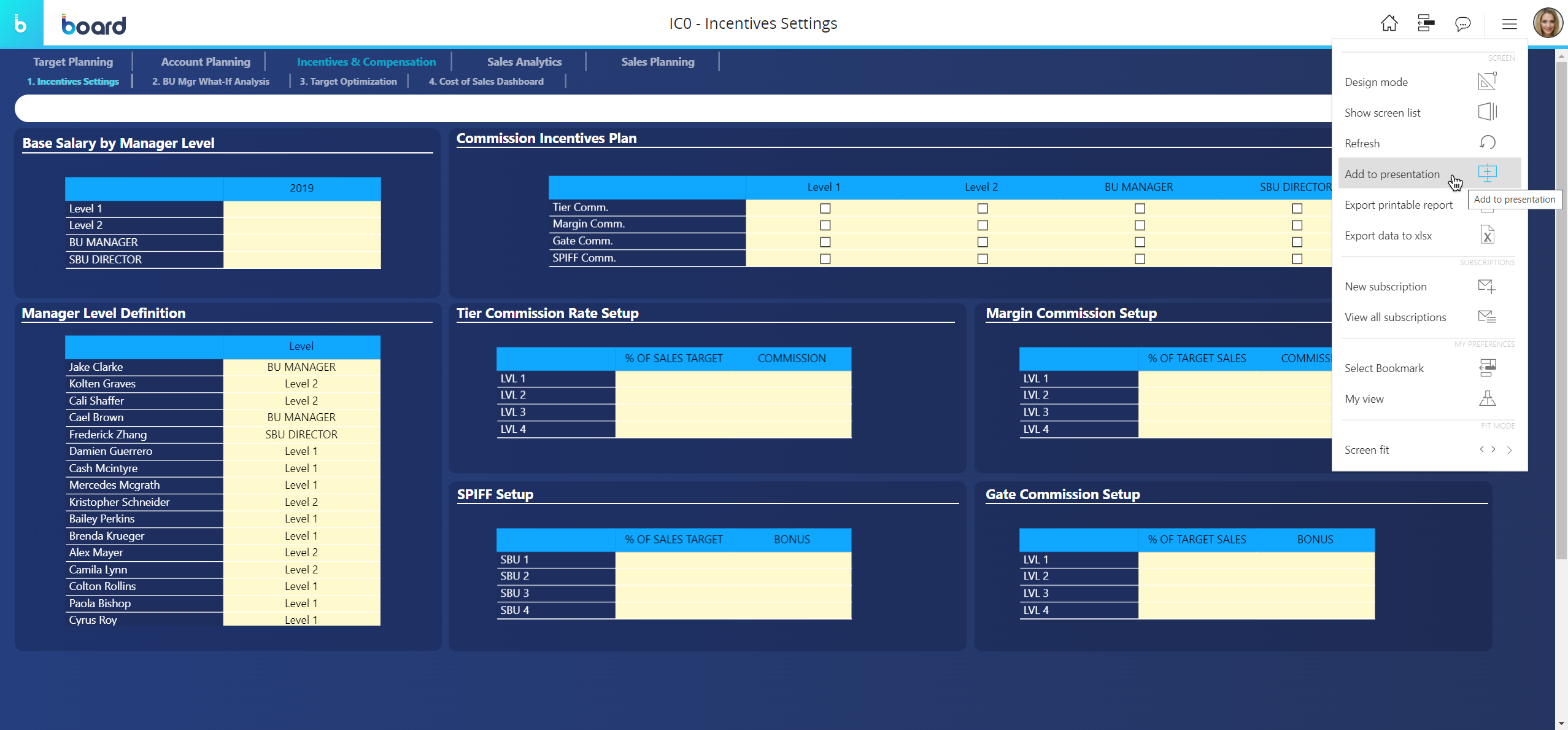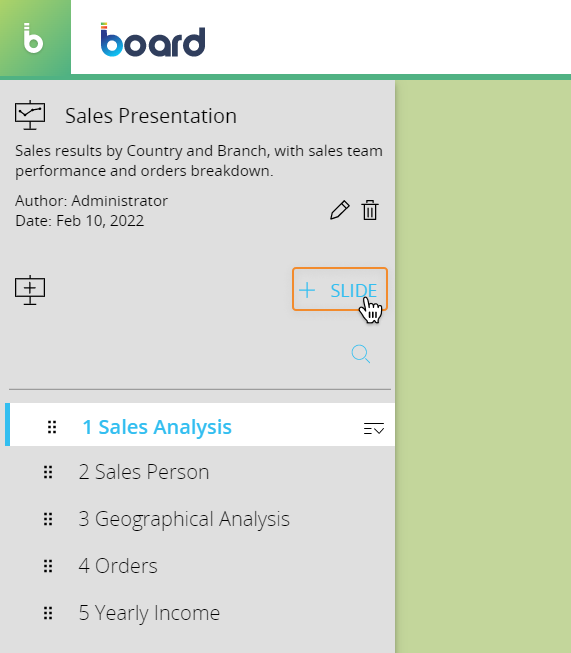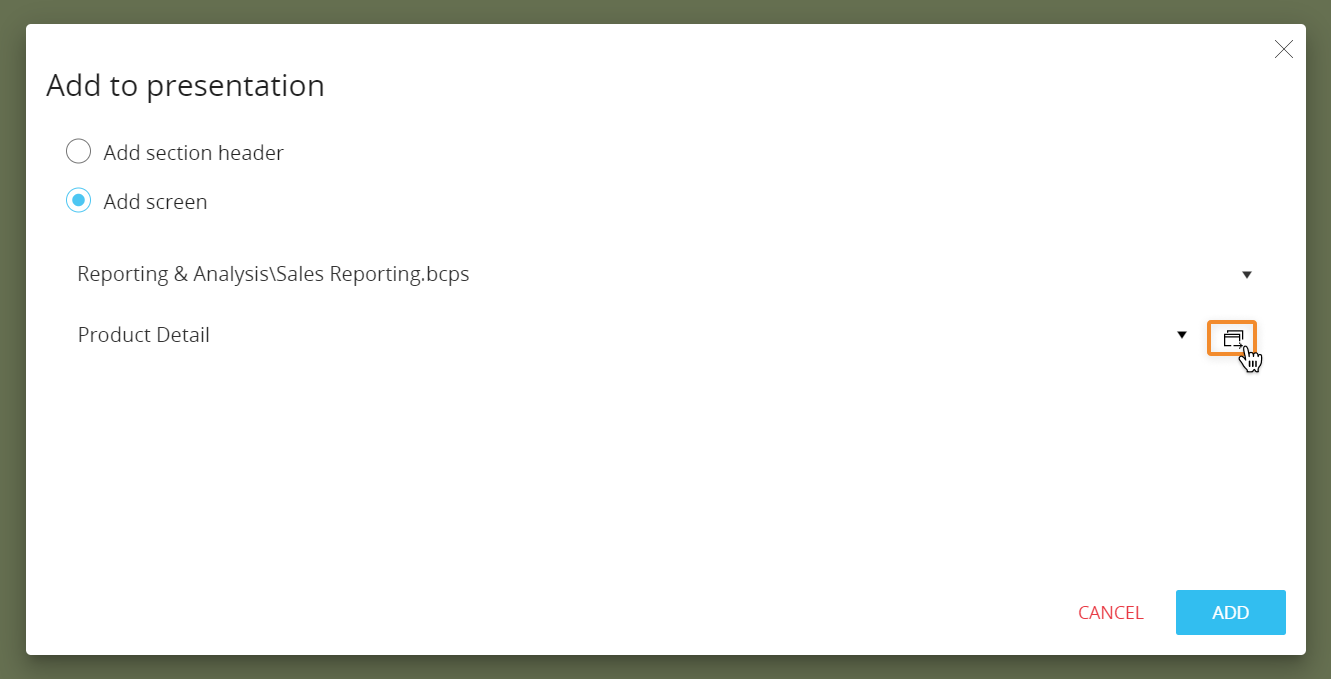Creating a Slide
This topic describes how to create a Slide in a Presentation.
There are two ways to create a Slide:
- From the Capsules environment
- From the Presentations environment
Creating a Slide from the Capsules environment
To create a new Slide from the Capsules environment, proceed as follows:
- Open the desired Capsule in Play mode and navigate to the Screen you want to add to a Presentation
- (Optional) Apply any changes to Layouts, drills, selections and filters (Pagers) as desired
- Hover over the burger icon in the Top menu and click on "Add to presentation"

- In the pop-up window give your new Slide a name and decide whether to add it to a new Presentation or to an existing one.
If you want to add the Screen to a new Presentation, give the new Presentation a name to continue - Click on "ADD" to open the newly created Slide in Edit mode.
When a Screen is added to a Slide, a link between the Slide and the Screen is created: the Screen is then displayed on the Slide with any custom settings applied (Layouts, selections and filters defined within the Capsule environment in Play mode).
- If you make changes to Layouts, drills, selections and filters of a Screen and you add it to a Presentation, the resulting Slide will save those changes and will show the linked Screen with those changes applied
- If you don't make changes to Layouts, drills, selections and filters of a Screen and you add it to a Presentation, the resulting Slide will reflect the linked Screen and will continue to do so as long as you don't apply changes to Layouts, selections and filters from within the Presentation environment in Edit mode.
Once you have added a Screen to a Presentation, you can make changes to Layouts, drills, selections and filters (Pagers) of that Screen in the Presentation environment by opening the corresponding Slide in Edit mode. These changes will automatically be saved when you switch to Play mode in the Presentation environment, but they won't affect the linked Screen in the Capsule environment. See About Presentations for more details.
In Edit mode, the side panel on the right of the page allows you to access additional Slide properties. See Edit and Play mode for more details.
Creating a Slide from the Presentations environment
You can also create a Slide from within the Presentations environment. To do so, proceed as follows:
- Open an existing Presentation in Edit mode
- From the side panel on the left of the page, click on the "+ SLIDE" button

- In the pop-up window, select which type of Slide you want to create: Section header or Screen.
- If you want to add a Section header, check the appropriate option
- If you want to add a Screen from a Capsule, check the appropriate option and select it using the underlying dropdown menus.
You can view the Screen you selected by clicking on the "Go to Screen" icon shown below. You will exit the current Presentation and be taken to the Screen in the Capsules environment

-
Click on "ADD" to open the newly created Slide in Edit mode.
If you add a Screen to a Presentation following the steps described above, the resulting Slide will show the linked Screen in its default view (i.e. as when you open the Screen in the Capsule environment). The Slide will continue to mirror the linked Screen as long as you don't apply changes to Layouts, drills, selections and filters from within the Presentation environment in Edit mode.
Once you have added a Screen to a Presentation following the steps described above, you can make changes to Layouts, drills, selections and filters (Pagers) of that Screen in the Presentation environment by opening the corresponding Slide in Edit mode. These changes will automatically be saved when you switch to Play mode in the Presentation environment, but they won't affect the linked Screen in the Capsule environment. See About Presentations for more details.
In Edit mode, the side panel on the right of the page allows you to access additional Slide properties. See Edit and Play mode for more details.
Another way to create a new Slide is to copy an existing one. This is particularly useful, for example, when you want to create Slides that include the same Objects but display different data.
See Copying a Slide for more details.
When you create a new Slide, it will always be added to the bottom of the Slide list on the left.
If the Screen list of a Capsule is hidden, you can't add any Screen of that Capsule to a Presentation.
Learn more:
- Copying a Slide
- Saving, renaming, moving, deleting a Slide
- About Presentations
- Presentations workspace
- Edit and Play mode